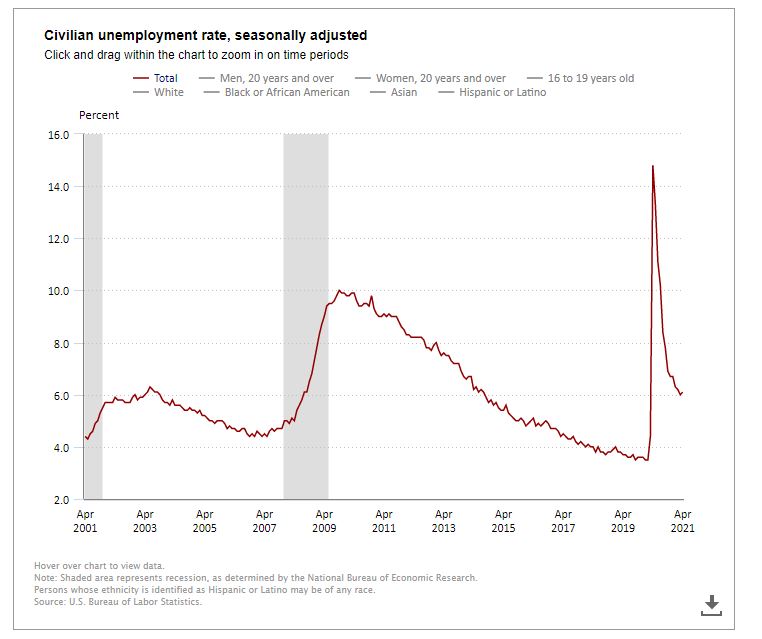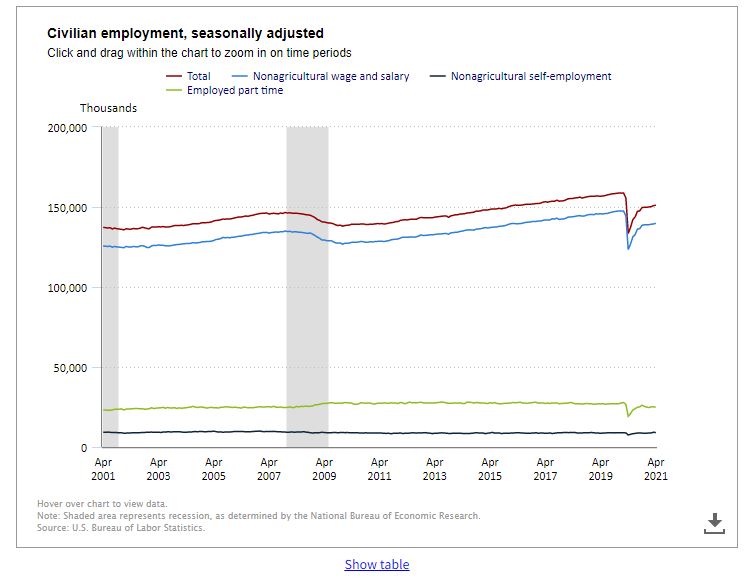Employment Blog May 2021
This employment blog is taken from the US Department of Labor, Bureau of Labor Statistics Reports. Total nonfarm payroll employment rose by 266,000 in April, and the unemployment rate was little changed at 6.1 percent. Notable job gains in leisure and hospitality, other services, and local government education were partially offset by losses in temporary help services and in couriers and messengers. Substantial job losses related to the coronavirus (COVID-19) pandemic first occurred in March (-1.7 million) and April (-20.7 million) of 2020. As economic activity resumed, employment increased by 12.6 million from May through November but declined again in December (-306,000) following a surge in the number of coronavirus cases. Job growth restarted in January of this year, and nonfarm payroll employment has increased by 1.8 million over the past 4 months. However, payroll employment is down by 8.2 million, or 5.4 percent, from the pre-pandemic employment peak in February 2020.


Leisure and hospitality gained 331,000 jobs in April, as pandemic-related restrictions continued to ease in many parts of the country. This followed job gains of 619,000 in February and March combined. Within the industry, job growth in food services and drinking places (+187,000) accounted for more than half of the April increase. Employment also rose in amusements, gambling, and recreation (+73,000) and in accommodation (+54,000). While leisure and hospitality has added 5.4 million jobs over the year, employment in the industry is down by 2.8 million, or 16.8 percent, since February 2020.
In April, employment in the other services industry increased by 44,000 but is down by 352,000 since February 2020. Over the month, job gains occurred in repair and maintenance (+14,000) and in personal and laundry services (+14,000).
Local government education added 31,000 jobs in April, following a gain of 28,000 in the prior month. Employment in local government education has fluctuated in recent months but is down by 611,000 since February 2020.
In April, social assistance employment rose by 23,000, with about half of the gain in child day care services (+12,000). Employment in social assistance is 286,000 lower than in February 2020.
Financial activities added 19,000 jobs in April, with most of the gain in real estate and rental and leasing (+17,000). Employment in financial activities is down by 63,000 since February 2020.
Within professional and business services, employment decreased by 111,000 in temporary help services in April, following little change in the previous month. Employment in temporary help services is 296,000 lower than in February 2020. Elsewhere in professional and business services, job losses occurred in business support services in April (-15,000), while architectural and engineering services (+12,000) and scientific research and development services (+7,000) added jobs.
Within transportation and warehousing, employment in couriers and messengers fell by 77,000 in April but is up by 126,000 since February 2020. Air transportation added 7,000 jobs in April. Overall, employment in transportation and warehousing is down by 142,000 since February 2020.
Manufacturing employment edged down by 18,000 in April. Within the industry, job losses in motor vehicles and parts (-27,000) and wood products (-7,000) were partially offset by job gains in miscellaneous durable goods (+13,000) and chemicals (+4,000). Since February 2020, employment in manufacturing is down by 515,000.
Employment in retail trade changed little in April (-15,000), following a gain in the prior month (+33,000). Within the industry, April job losses in food and beverage stores (-49,000), general merchandise stores (-10,000), and gasoline stations (-9,000) were partially offset by job gains in sporting goods, hobby, book, and music stores (+20,000); clothing and clothing accessories stores (+10,000); and health and personal care stores (+9,000). Overall, employment in retail trade is 400,000 lower than in February 2020.
Health care employment changed little in April (-4,000). Ambulatory health care services added 21,000 jobs, while nursing care facilities continued to lose jobs (-19,000). Health care employment is 542,000 below the February 2020 level.
Construction employment was unchanged in April. Employment in the industry is up by 917,000 over the year but is 196,000 lower than in February 2020.
Employment in other major industries–including mining, wholesale trade, and information–showed little change over the month.
The Consumer Price Index for All Urban Consumers (CPI-U) increased 0.8 percent in April on a seasonally adjusted basis after rising 0.6 percent in March, theU.S. Bureau of Labor Statistics reported today. Over the last 12 months, the all items index increased 4.2 percent before seasonal adjustment. This is the largest 12-month increase since a 4.9-percent increase for the period ending.
